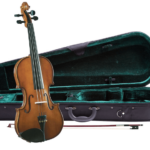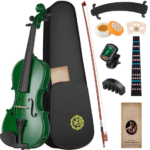For many people, it is almost impossible to tell the difference between a viola and a violin. Aside from being both string instruments, they are also played on the shoulder with the bow under your chin. Knowing the differences between viola vs violin is crucial to help you decide which one is a better option.
Viola and violin are two string instruments from Italy. They are commonly found in an orchestra and have an almost identical appearance. If you look and listen closely, however, you will see and hear the differences.
The table below summarizes some of the things that differentiate one from the other:
| VIOLA | VIOLIN | |
| Size | Larger, usually ranges from 18 ½” to 27 1/8″ | Smaller, usually 14 1/8″ to 23 5/8″ |
| Weight | Heavier, approximately 580 pounds | Lighter, around 460 pounds |
| Strings | A, D, G, and C | E, A, D, and G |
| Bow | Heavier with round frog | Lighter with pointy frog |
| Clef | Alto | Treble |
| Tuning | C3, G3, A4 | G3, D4, A4 |
| Orchestra | One | Two |
| Sound | Deep and mellow | High pitch |
| Notes | C – lowest, A – highest | G – lowest, E – highest |
| Playing | Heavy with thick strings and wider gaps that require more effort | Lightweight with thin strings that do not require much finger precision |
| Cost | Slightly more expensive | Slightly more affordable |
Read on to learn more about viola vs violin, including their size, sound, and strings, among other things.
Also, we hope you find the links here useful. We may get a commission if you purchase something through a link on this page, so thank you!
Viola vs Violin

Click here to see this Mendini 14-Inch MA250 Varnish Solid Wood Viola on Amazon.
While both may seem the same from afar, you will realize key differences if you look closer. Below, I will share some of the things that set them apart:
1. Size
With a quick look at the two string instruments, one of the easiest ways to tell is by looking at their size. Between the two, the viola is slightly larger than a violin. A viola is also deeper and wider.
On average, the length of a viola ranges from 18 ½” to 27 1/8″. Meanwhile, a violin is only 14 1/8″ to 23 5/8″. The difference can be slight, but it is easily noticeable when you put the two next to each other.
2. Weight
The difference in size also results in a difference in weight. Because a viola is larger, it follows that it is slightly heavier. On average, it weighs 580 grams. On the other hand, since the violin is smaller, it is also lighter. It weighs approximately 460 pounds. The specific weight may differ depending on various factors, such as the main material.
3. Strings
In comparing violin vs. viola, it is also crucial that we talk about the strings. If you look at the two instruments from afar, you will assume they have the same strings. However, a violin has E, A, D, and G strings. The highest is E, and the lowest is G. They are tuned ¼ under each string. As for a viola, there are A, D, G, and C strings. The highest is A, and the lowest is C.
More so, they are also different in terms of the distance between the strings. A viola has a wider gap. Plus, it has a lower scale compared to the strings in a violin.
Watch this video to learn more about the strings of violin and viola.
4. Bow
The bow is one of the most important components of the two instruments. It is what will let you produce sound. You cannot use the same bow for both. Because of the viola’s heavier strings, it needs a tougher bow. It is heavier by as much as 10 grams compared to a violin’s bow.
Additionally, the frog is also different in the two bows. The frog is the part of the bow that you will hold. In a viola, the bow is round while it is pointy on a violin.
5. Clef
When referring to the sheet music of the two instruments, you must know how to read properly. You will be using an alto clef in a viola. Also called the viola clef or C clef, it takes a bit of practice to read such. You will find the alto clef in a beautifully symmetrical position on a central line. It is also used by alto singers, and hence, the name.
Meanwhile, a violin has a treble clef. This is precisely the case when the violinist is playing music in a high register. Because of this, it is famous as the soprano of an orchestra.
6. Tuning
Whether you are using a viola or violin, proper tuning is important. It helps in engaging the ear on the sound and frequency that you prefer. This will make sure that the instrument will replicate the exact tune that you are playing.
One of the differences between the two is that you will tune a viola one-fifth lower than tuning a violin. Most people tune viola strings to C3, G3, and A4. On the other hand, the most common options for tuning violin strings are G3, D4, and A4.
7. Orchestra
Both instruments are common in an orchestra. Often, you will find two violins in an orchestra. Having first and second violins will help improve the melody, especially giving its mellow sound. On the contrary, only one viola has the main role of creating rhythm and harmony. It is often on the right side at the middle of the second violin and cello.
8. Sound
With the differences in the strings and the clefs, among other things, you can expect that the two string instruments produce different sounds. They may look alike, but they have distinct sounds if you listen closely when played.
Viola Has Deeper but More Mellow Sound
A viola has a deeper but more mellow sound. This is because of its lower C string and the notes that you will play in the instrument. It provides harmonic and rhythmic elements in chamber ensembles and symphonies.
A Violin Produces a Higher Pitch
Meanwhile, a violin produces a higher pitch. It has flute-like sounds and natural harmonics. Additionally, it is more resonant and richer. The sound is comparable to bass or cello. It carries the melody in music, so it is common to have two violins in an orchestra.
Again, what’s the difference between viola and violin? The most noticeable difference between violin and viola is their size. Viola is bigger with an average size of 18 ½ inches to 27 1/8 inches, while violin’s average size ranges between 14 1/8 inches to 23 5/8 inches.
This video will show the differences in the way the two instruments sound.
9. Notes
Speaking of the differences in the sound that they generate, these string instruments also have different notes. The variations in the spectrum and length of the strings are responsible for the disparity in their note range.
The lowest open tone in viola starts at C and G in a violin. Meanwhile, the highest note in violin is E and A in a viola. You can play the 4-octave range on both instruments. The main difference is that viola can have a lower range.
10. Playing
Playing these two string instruments will also require a different approach. Larger than a violin, a viola is more challenging to handle. Some might be uncomfortable. Nonetheless, it is generally easier to play for a newbie because of the spacing of the strings.
Aside from the significant gap, the strings are also thicker, so you will need more pressure from your fingers. In contrast, a violin requires less fingering precision.
When you are playing the viola and violin, you will assume the same starting position. The instrument’s body should lean on your left shoulder while you put your jaw on the chinrest. Your right hand, meanwhile, will move the bow, while your left fingers are pressing the string.
11. Cost
The specific price will depend on various factors, such as the manufacturer’s reputation and the overall quality. While the cost does not vary that much, a viola is often more expensive. The latter is because it is slightly larger with thicker strings. Also, the supply is more limited than a violin, which is why it is more expensive.
Similarities Between Viola and Violin

Click here to see this Eastar Violin 4/4 Full Size for Adults on Amazon.
They may be different in a lot of ways, but they also share common characteristics. Below is a quick rundown of some of their similarities:
1. Number of Strings
Another similarity between the two is they both have four strings. Nonetheless, as I talked about above, the strings are different. A viola has thicker strings, which is also because of its larger size. To add, the tuning of the strings is also different.
2. Positioning
Aside from the number of strings, they are also the same regarding their position and how you hold them. The instrument is placed on the shoulder with your hand on the other side holding the bow.
3. Origin
The two string instruments are from Europe, specifically Italy. Both instruments were from a native European instrument known as the viol. Then, viola has two varieties:
- Viola da braccio
- Vola da gamba or arm viol and leg viol
Lastly, these instruments are popular as Renaissance instruments that some of the best musicians have played.
Tips and Tricks for Playing Viola and Violin

Click here to see this Mendini By Cecilio Violin For Kids & Adults on Amazon.
Playing a viola or violin is intimidating for first-timers. From the proper hand positioning to finger placement on the strings, you have a lot of things to learn.
Below is a rundown of some of the most important things to consider:
1. Start by Warming Up
This will get you physically and mentally ready. Practice deep and slow breathing. Move your fingers and wrists. Calm your mind.
2. Pick the Right Size
It is a good idea if you can physically try the instrument before purchasing. This way, you will be more confident of the right fit and optimal comfort.
3. Practice the Right Posture
This will not only enhance sound quality but will also make you more comfortable. Do not hold the instrument and the bow too tight or too loose.
4. Observe the Right Speed When Moving the Bow
Go with the rhythm. Being too slow or too fast will impact how the viola or violin produces sound.
5. Read Through the Sheets Before Playing
This will prepare you for what lies ahead, so you will know exactly what to do.
6. Practice Makes Perfect
As a beginner, the experience can be frustrating. Do not give up. The more determined you are, the easier it is to succeed.
Conclusion – Viola vs Violin
Choosing a string instrument can be overwhelming, especially for someone who has no extensive knowledge. They are confusing and overwhelming. With this, you must know the differences between viola vs violin. They might initially look the same, but you will see the distinctions if you look closer and listen to it being played.
They both have four strings and originated in Europe. However, a viola is slightly larger, which also makes it heavier. More so, it has thicker strings, which require a tougher bow with a round frog. As for the music, it is deep and mellow. Playing this instrument can require more effort because of its size and weight.
On the other hand, a violin is a bit smaller and lighter in terms of weight. It has a pointy frog in its bow. Additionally, it generates high pitch sound. In an orchestra or symphony, you will often find two violins while there is only one viola.
Read next:













![Read more about the article Types of Violins [10 Different Violin Types]](https://musicalinstrumentpro.com/wp-content/uploads/2021/01/types-of-violins-300x200.jpg)